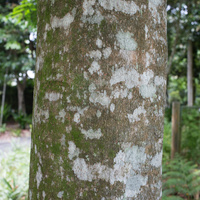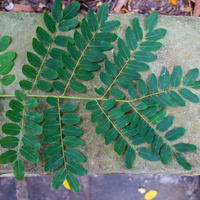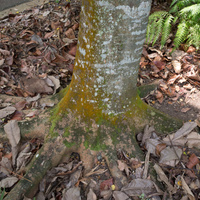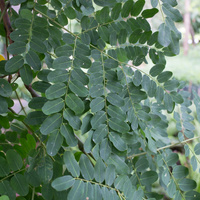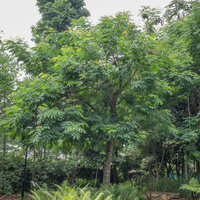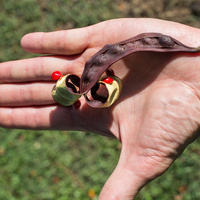Common name: Red Sandalwood
Other common names: Circassian Bean, Circassian Seed, Coral Wood, Jubie Beads, False Wiliwili, Peacock Tree, Red Bead Tree, Saga Tree, Sanderswood
Description
Red Sandalwood is a timber and fuelwood tree with a wide natural distribution, its native range extending from India through Southeast Asia to Australia and the Western Pacific. And from there, it was introduced into countries in Africa, the Caribbean and Central America, where it has become well-established and naturalised.
It attains heights of up to 25 m (82 ft) in its natural forests, though it is more commonly 10 to 15 m (32 to 50 ft) tall. Under favourable conditions, it develops a single trunk that supports a wide-spreading, rounded crown. However, it is often forked or multi-trunked in the drier parts of its range, especially on nutrient-poor soils. The bark is dark brown and slightly fissured.
The leaves are 30 to 60 cm (1 to 2 ft) long and twice-feathered, consisting of many dull green, oblong leaflets with blunt ends, alternately arranged along the ends of the branches. In seasonally dry areas, they fall from the tree to conserve water.
The flowers are small and insignificant, creamy-white to pale yellow, tightly packed in narrow, tail-like clusters arising at the ends of the branches. They bloom from late summer to early winter and are followed by slim seedpods up to 25 cm (10 in) long.
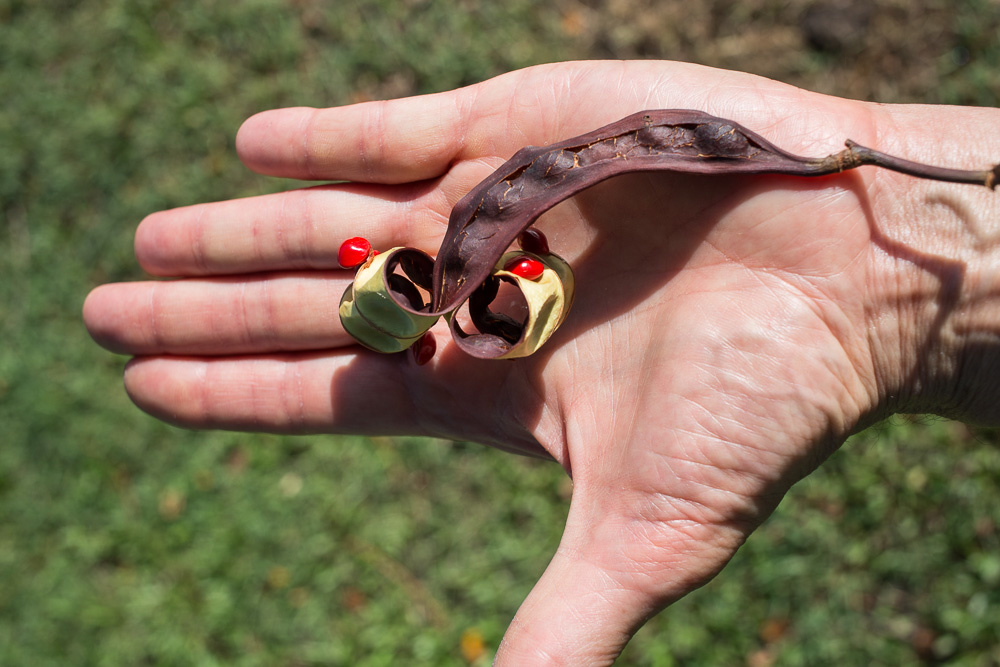
Darwin, Australia
Use
The wood is medium-weight to heavy, in the 600 to 800 kgs per cubic meter (37 to 50 lbs per cubic ft) range and has good natural resistance to rot and decay. This makes it suitable for indoor and outdoor construction.
When sawn, it reveals attractive dark reddish-brown, wavy-patterned heartwood, used mainly for making furniture and cabinets. Small diameter lengths are cut for in-ground poles and posts, such as fence posts and for firewood and charcoal, to which it is well suited.
It was once commonly planted to shade coffee (Coffea arabica) and cacao (Theobroma cacao) crops because of its fast growth and moderate shading, allowing some sunlight to pass through to the crops below. However, this use is now discouraged due to its weediness.
The shiny red seed are softened in boiling water and threaded to make fashion jewellery, including necklaces, bracelets and other wearable fashion, sometimes intricately designed.
Climate
Grows naturally in moderately humid to humid tropical lowland climates, generally areas with annual lows of 18 to 25°C, annual highs of 27 to 36°C, annual rainfall of 1200 to 6000 mm and a dry season of 5 months or less, extending to 7 months with irrigation or groundwater. However, it reaches its best development as a timber tree in areas with annual rainfall of 1800 mm or more.
Growing
New plants are usually started from seed, which are sometimes slow to germinate. They are best pre-treated by immersing them in boiling water for around a minute or leaving them to soak in tap water for a day or two. Seedlings and mature trees perform best on free-draining clay-loam, loam, sandy-loam and loamy-sand soils of a moderately acid to neutral nature, generally with a pH of 5.5 to 7.5, and on sites with full to partial sun exposure.
Problem features
It is listed as a high weed risk in more than one reference publication. A high seed production rate and the speed with which dense stands can form causes it to displace native flora, preventing their regeneration. Humans are mainly responsible for its spread outside of its native range by importing and cultivating it as an ornamental and with seed-eating birds the primary dispersal agent. It is assessed as a high weed risk species for Hawaii by the Hawaii Pacific Weed Risk Assessment (HPWRA) project.
The seed are reportedly poisonous if ingested.
Where it grows
References
Books
-
Allen, O. N. & Allen, E. K. 1981, The Leguminosae : a source book of characteristics, uses, and nodulation, University of Wisconsin Press, Madison, Wisconsin
-
Barwick, M., et al. 2004, Tropical & subtropical trees : a worldwide encyclopaedic guide, Thames and Hudson, London
-
Bonner, F. T & Karrfalt, R. P. 2008, The woody plant seed manual, U.S. Department of Agriculture, Forest Service, Washington D.C.
-
C.A.B. International 2013, The CABI encyclopedia of forest trees, CABI Publishing, Wallingford, Oxfordshire
-
Dastur, J. F. 1964, Useful plants of India and Pakistan : a popular handbook of trees and plants of industrial, economic, and commercial utility, 2nd ed., D. B. Taraporevala Sons, Bombay
-
Fawcett, W. 1891, Economic plants, An index to economic products of the vegetable kingdom in Jamaica, Jamaica Government Printing Establishment, Kingston
-
Francis, J. K. 1998, Tree species for planting in forest, rural, and urban areas of Puerto Rico, U.S. Department of Agriculture, Forest Service, International Institute of Tropical Forestry, Río Piedras, Puerto Rico
-
Francis, J. K. and Liogier, H. A. 1991, Naturalized exotic tree species in Puerto Rico, General technical report SO-82, USDA Forest Service, Southern Forest Experiment Station, New Orleans
-
Gohl, B. 1981, Tropical Feeds : feed information summaries and nutritive values (Revised edition), Food and Agriculture Organization of the United Nations (FAO), Rome
-
Holttum, R. E. & Enoch, I. C. 2010, Gardening in the tropics : the definitive guide for gardeners, Marshall Cavendish Editions, Singapore
-
Howes, F. N. 1949, Vegetable gums and resins, Chronica Botanica Company, Waltham, Massachusetts
-
Jamieson, G. S. 1943, Vegetable fats and oils : their chemistry, production, and utilization for edible, medicinal and technical purposes, 2d ed, Reinhold, New York
-
Krishen, P. 2006, Trees of Delhi : a field guide, Dorling Kindersley Publishers, Delhi
-
Little, E. L. et al. 1964 and 1974, Common trees of Puerto Rico and the Virgin Islands (2 volumes), Forest Service, U.S. Department of Agriculture (USDA), Washington D.C.
-
Macmillan, H. F. 1943, Tropical planting and gardening : with special reference to Ceylon, 5th ed, Macmillan Publishing, London
-
Nussinovitch, A. 2010, Plant gum exudates of the world : sources, distribution, properties, and applications, CRC Press / Taylor & Francis, Boca Raton, Florida
-
Parrotta, J. A. 2001, Healing plants of peninsular India, CABI Publishing, Wallingford, Oxfordshire
-
Peate, N. & Macdonald, G. & Talbot, A. 2006, Grow what where : over 3,000 Australian native plants for every situation, special use and problem area, 3rd ed., Bloomings Books, Richmond, Victoria, Australia
-
Perkins, K. D. & Payne, W. 1981, Guide to the poisonous and irritant plants of Florida, Florida Cooperative Extension Service, Gainesville, Florida
-
Polunin, Ivan 1987, Plants and flowers of Singapore, Times Editions, Singapore
-
Randall, R. P. 2002, A global compendium of weeds, R.G. and F.J. Richardson Press, Melbourne
-
Randall, R. P. 2007, The introduced flora of Australia and its weed status, Cooperative Research Centre for Australian Weed Management, Glen Osmond, South Australia
-
Selvam, V. 2007, Trees and shrubs of the Maldives, Food and Agriculture Organisation (FAO) RAP publication (Maldives), Thammada Press Company Ltd., Bangkok
-
Streets, R. J. & Troup, R. S. 1962, Exotic forest trees in the British Commonwealth, Oxford University Press, Oxford, England
-
Troup, R.S. & Joshi, H. B. 1975 to 1981, Silviculture of Indian Trees (3 volumes), Government of India Publications, New Delhi
-
Vozzo, J. A 2002, Tropical tree seed manual, U.S. Department of Agriculture (USDA), Forest Service, Washington D.C.
-
Watt, George Sir 1908, The commercial products of India : being an abridgement of the Dictionary of the economic products of India, John Murray, London
Articles, Journals, Reports and Working Papers
-
Morton, J. F. 1976, Pestiferous spread of many ornamental and fruit species in south Florida. In Proceedings of the Florida State Horticultural Society (Vol. 89, pp. 348-353).
